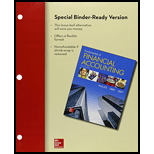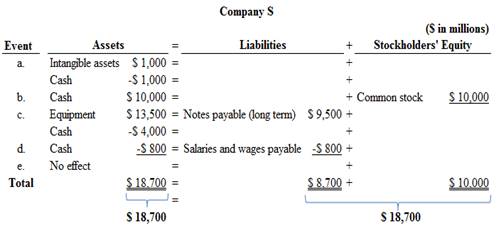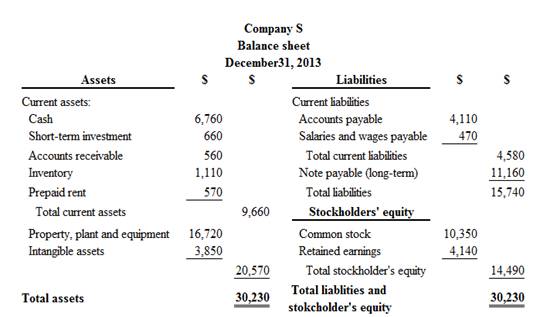
Requirement – 1
To analyze: The given transaction, and explain their effect on the
Requirement – 1
Explanation of Solution
Accounting equation is an accounting tool expressed in the form of equation, by creating a relationship between the resources or assets of a company, and claims on the resources by the creditors and the owners. Accounting equation is expressed as shown below:
Accounting equation for each transaction is as follows:

Figure (1)
Therefore, the total assets are equal to the liabilities and stockholder’s equity.
Requirement – 2
To record: The
Requirement – 2
Explanation of Solution
Journal:
Journal is the method of recording monetary business transactions in chronological order. It records the debit and credit aspects of each transaction to abide by the double-entry system.
Rules of Debit and Credit:
Following rules are followed for debiting and crediting different accounts while they occur in business transactions:
- Debit, all increase in assets, expenses and dividends, all decrease in liabilities, revenues and stockholders’ equities.
- Credit, all increase in liabilities, revenues, and stockholders’ equities, all decrease in assets, expenses.
Journal entries of Company S are as follows ($ in millions):
a. Intangible assets purchased in cash:
| Date | Accounts title and explanation | Ref. | Debit ($) | Credit ($) |
| Intangible assets(+A) | 1,000 | |||
| Cash (-A) | 1,000 | |||
| (To record purchase of supplies in cash) |
Table (1)
- Inventories are an assets account and it increased the value of asset by $1,000. Hence, debit the inventories account for $1,000.
- Cash is an assets account and it decreased the value of asset by $1,000. Hence, credit the cash account for $1,000.
b. Issuance of common stock:
| Date | Accounts title and explanation | Ref. | Debit ($) | Credit ($) |
| Cash (+A) | 10,000 | |||
| Common stock (+SE) | 10,000 | |||
| (To record the issuance of common stock) |
Table (2)
- Cash is an assets account and it increased the value of asset by $10,000. Hence, debit the cash account for $10,000.
- Common stock is a component of stockholder’s equity and it increased the value of stockholder’s equity by $10,000, Hence, credit the common stock for $10,000.
c. Equipment purchased on account and in cash:
| Date | Accounts title and explanation | Ref. | Debit ($) | Credit ($) |
| Equipment (+A) | 13,500 | |||
| Cash (-A) | 4,000 | |||
| Notes payable (+L) | 9,500 | |||
| (To record purchase of equipment on account and in cash) |
Table (3)
- Equipment is an assets account and it increased the value of asset by $13,500. Hence, debit the equipment account for $13,500.
- Cash is an assets account and it decreased the value of asset by $4,000. Hence, credit the cash account for $4,000.
- Notes payable is a liability account, and it increased the value of liabilities by $9,500. Hence, credit the notes payable for $9,500.
d. Salaries paid to employees
| Date | Accounts title and explanation | Ref. | Debit ($) | Credit ($) |
| Salaries and wages payable (+L) | 800 | |||
| Cash (-A) | 800 | |||
| (To recordcash paid to employees) |
Table (4)
- Notes payable is a liability account, and it decreased the value of liabilities by $800. Hence, debit the notes payable for $800.
- Cash is an assets account and it decreased the value of asset by $800. Hence, credit the cash account for $800.
e. Conducted negotiations to purchase a coffee form:
In this case, no entry required, because it is not a business transaction.
Requirement – 3
To prepare: T-account for each account listed in the requirement 2.
Requirement – 3
Explanation of Solution
T-account:
T-account refers to an individual account, where the increasesor decreases in the value of specific asset, liability, stockholder’s equity, revenue, and expenditure items are recorded.
This account is referred to as the T-account, because the alignment of the components of the account resembles the capital letter ‘T’.’ An account consists of the three main components which are as follows:
- (a) The title of the account
- (b) The left or debit side
- (c) The right or credit side
T-accounts of Company S are as follows ($ in millions):
| Cash (A) | |||
| Beg. | 2,560 | ||
| (b) | 10,000 | 1,000 | (a) |
| 4,000 | (c) | ||
| 800 | (d) | ||
| End. | 6,760 | ||
| Beg. | 560 | ||
| End. | 560 | ||
| Inventory (A) | |||
| Beg. | 1,110 | ||
| End. | 1,110 | ||
| Prepaid rent (A) | |||
| Beg. | 570 | ||
| End. | 570 | ||
| Short-term investment (A) | |||
| Beg. | 660 | ||
| End. | 660 | ||
| Intangible assets (A) | |||
| Beg. | 2,850 | ||
| (a) | 1,000 | ||
| End. | 3,850 | ||
| Equipment (A) | |||
| Beg. | 3,220 | ||
| (c) | 13,500 | ||
| End. | 16,720 | ||
| Accounts payable (L) | |||
| 4,110 | Beg. | ||
| 4,110 | End. | ||
| Salaries and wages payable (L) | |||
| 1,270 | Beg. | ||
| (d) | 800 | ||
| 470 | End. | ||
| Notes payable (long-term) (L) | |||
| 1,660 | Beg. | ||
| 9,500 | (c) | ||
| 11,160 | End. | ||
| Common Stock (SE) | |||
| 350 | Beg. | ||
| 10,000 | (b) | ||
| 10,350 | End. | ||
| 4,140 | Beg. | ||
| 4140 | End. | ||
Requirement – 4
To explain: The response for event (e).
Requirement – 4
Explanation of Solution
Business transaction:
Business transaction is a record of any economic activity, resulting in the change in the value of the assets, the liabilities, and the stockholder’s equities, of a business. Business transaction is also referred to as financial transaction.
In this case, conducting negotiation to purchase a coffee form is not creating any impact on assets, liabilities and stockholder’s equity of the business, because it is not a business transaction.
Requirement – 5
To prepare: The classified balance sheet of Company S at December 31, 2013.
Requirement – 5
Explanation of Solution
Classified balance sheet:
This is the financial statement of a company which shows the grouping of similar assets and liabilities under subheadings.
Classified balance sheet of Company S is as follows ($ in millions):

Figure (2)
Therefore, the total assets of Company S are$30,230 million, and the total liabilities and stockholders’ equity is$30,230 million.
Requirement – 6
Whether the assets amount of Company S is primarily come from liabilities or stockholders’ equity.
Requirement – 6
Explanation of Solution
The invested amount of assets are primarily come from liabilities (current and non-current) of Company S, because liabilities financed $15,740 million of the Company S’s total assets, and stockholder’s equity (common stock) financed $14,490 million.
Requirement – 7
The current ratio of Company S and compare with Company L’s current ratio.
Requirement – 7
Explanation of Solution
Current Ratio:
A part of
Calculate the current ratio of Company S as follows:
Here,
Current assets = $5,460million (1)
Current liabilities= $5,380 million(2)
Therefore, the current ratio of Company S is 1.01.
Current ratio of Company S is 1.01 and Company A is 1.68, so Company S has less current ratio than Company A and it indicates Company A has better position to repay the liabilities.
Working note:
Calculate the value of current assets before given error transaction:
Calculate the value of current liabilities before given error transaction:
Want to see more full solutions like this?
Chapter 2 Solutions
Loose-leaf for Fundamentals of Financial Accounting with Connect
- Income Statement and Balance Sheet Fort Worth Corporation began business in January 2016 as a commercial carpet-cleaning and drying service. Shares of stock were issued to the owners in exchange for cash. Equipment was purchased by making a down payment in cash and signing a note payable for the balance. Services are performed for local restaurants and office buildings on open account, and customers are given 15 days to pay their accounts. Rent for office and storage facilities is paid at the beginning of each month. Salaries and wages are paid at the end of the month. The following amounts are from the records of Fort Worth Corporation at the end of its first month of operations: Required Prepare an income statement for the month ended January 31, 2016. Prepare a balance sheet at January 31, 2016. What information would you need about Notes Payable to fully assess Fort Worths longterm viability? Explain your answer.arrow_forwardAnalyze The Home Depot for three years The Home Depot, Inc. (HD), is the worlds largest home improvement retailer and one of the largest retailers in the United States based on sales volume. Home Depot operates over 2,200 stores that sell a wide assortment of building, home improvement, and lawn and garden items. Home Depot recently reported the following end-of-year balance sheet data (in millions): a. Compute the ratio of liabilities to stockholders equity for all three years. Round to two decimal places. b. What conclusions regarding the margin of protection to creditors can you draw from the trend in this ratio for the three years?arrow_forwardOn December 31, 2018, the balances of the accounts appearing in the ledger of Home City Furnishings Company, a furniture wholesaler, are as follows: Rent revenue $12,000 Sales $3,250,000 Accounts receivable 500,000 Cash 530,000 Administrative Expenses 200,000 Cost of Merchandise Sold 1,600,000 Selling Expenses 250,000 Interest expense 6,000 Prepare a multi-step income statement for the year ended December 31, 2018. Home City Furnishings Company Income Statement December 31, 2018 Sales Less Operating Expenses: Other Revenue and Expense: Net Incomearrow_forward
- Comparing Two Companies in the Same Industry: Chipotle and Panera Bread Refer to the financial information for Chipotle and Panera Bread reproduced at the end of this book and answer the following questions: Required What is the dollar amount of inventories that each company reports on its balance sheet at the end of the most recent year? What percentage of total assets do inventories represent for each company? What does this tell you about the nature of their business? Refer to Note 1 in Chipotles annual report. What inventory valuation method does the company use? Refer to Note 2 in Panera Breads annual report. What inventory valuation method does the company use? How do both companies deal with situations in which the market value of inventory is less than its cost? Given the nature of their businesses, which inventory system, periodic or perpetual, would you expect both Chipotle and Panera Bread to use? Explain your answer.arrow_forwardComparing Two Companies in the Same Industry: Chipotle and Panera Bread Refer to the financial information for Chipotle and Panera Bread reproduced at the back of the book and answer the following questions. What was the total revenue for each company for the most recent year? By what percentage did each companys revenue increase or decrease from its total amount in the prior year? What was each companys net income for the most recent year? By what percentage did each companys net income increase or decrease from its net income for the prior year? What was the total asset balance for each company at the end of its most recent year? Among its assets, what was the largest asset each company reported on its year-end balance sheet? Did either company pay its stockholders any dividends during the most recent year? Explain how you can tell.arrow_forwardDiscuss how each of the following transactions for Watson, International, will affect assets, liabilities, and stockholders equity, and prove the companys accounts will still be in balance. A. An investor invests an additional $25,000 into a company receiving stock in exchange. B. Services are performed for customers for a total of $4,500. Sixty percent was paid in cash, and the remaining customers asked to be billed. C. An electric bill was received for $35. Payment is due in thirty days. D. Part-time workers earned $750 and were paid. E. The electric bill in C is paid.arrow_forward
 Financial AccountingAccountingISBN:9781337272124Author:Carl Warren, James M. Reeve, Jonathan DuchacPublisher:Cengage Learning
Financial AccountingAccountingISBN:9781337272124Author:Carl Warren, James M. Reeve, Jonathan DuchacPublisher:Cengage Learning Financial AccountingAccountingISBN:9781305088436Author:Carl Warren, Jim Reeve, Jonathan DuchacPublisher:Cengage Learning
Financial AccountingAccountingISBN:9781305088436Author:Carl Warren, Jim Reeve, Jonathan DuchacPublisher:Cengage Learning Financial Accounting: The Impact on Decision Make...AccountingISBN:9781305654174Author:Gary A. Porter, Curtis L. NortonPublisher:Cengage Learning
Financial Accounting: The Impact on Decision Make...AccountingISBN:9781305654174Author:Gary A. Porter, Curtis L. NortonPublisher:Cengage Learning Financial And Managerial AccountingAccountingISBN:9781337902663Author:WARREN, Carl S.Publisher:Cengage Learning,Principles of Accounting Volume 1AccountingISBN:9781947172685Author:OpenStaxPublisher:OpenStax College
Financial And Managerial AccountingAccountingISBN:9781337902663Author:WARREN, Carl S.Publisher:Cengage Learning,Principles of Accounting Volume 1AccountingISBN:9781947172685Author:OpenStaxPublisher:OpenStax College





